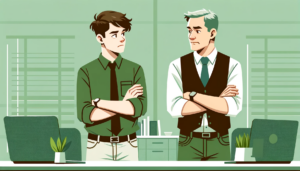How to build a resilient organisation in the wake of the Great Resignation
- 7 Min Read
In this article, HRD thought leader Professor Vlatka Hlupic outlines 8 specific actions for HR to effectively guide leaders and change organisational mindset and culture.
- Author: Idris Nagri
- Date published: Apr 13, 2022
- Categories

The Great Resignation is here. Many employees intend to leave their company sooner rather than later because they perceive they can get a better deal or find more freedom or responsibility elsewhere.
With the changes in the workplace, people are quitting their jobs en masse to pursue a start-up dream, a change in career, job shift or to start up their own business.
A recent global survey conducted by EY discovered that more than half of polled employees globally would consider leaving their job after Covid-19 if they were not given some type of flexibility in where and when they work. Job retention also varies by age, with millennials twice as likely to resign as baby boomers, with many young professionals reporting remote working as a major element in their job search.
Shifting mindsets
Leaders and organisations are realising that they need to shift their mindset and organisational culture if they are to embrace change and progress. Temporary fixes will no longer work. Instead, a more long-term, sustainable approach is required.
There is a need for more transparency, communication and trust within organisations. Leaders must be agile and be able to pivot quickly when needed.
They must also be more humane, and work to understand the emotional needs of their employees. Leaders must be willing to let go of their old ways of thinking and be open to newer ways of doing things. Peter Drucker said, “The greatest danger in times of turbulence is not the turbulence—it is to act with yesterday’s logic” – this quote is now more important than ever before.
To weather the storm of uncertainty and change, your organisation must have resilience and agility. Having the right mindset and culture is key to achieving this.
A resilient organisation is one that can quickly adapt to changes and bounce back from set-backs, always looking for new ways to improve and succeed. A resilient and agile organisation can react quickly to changes in the market and is not afraid of taking risks.

The moment we stop focusing on short term quick fixes is the moment where we will be able to focus far more seriously on building high performing organisations for the long term. This will mean a real alignment of purpose and values, as well as clear levels of responsibility for all employees in the organisation.
These are not the kind of problems that can be solved with a retreat or a training session. They are systemic problems that have built up over many years and are deeply embedded in organisational culture.
To address the above issues, an organisation needs to adopt, what I call, Level 4 mindset and culture.
What is a level 4/5 mindset and culture?
Based on many years of my interdisciplinary research, I have developed a 5-Level Model known as The Management Shift framework. The model shows 5 Levels that our individual mindset goes through and there is a corresponding organisational culture at every level. For individuals and organisations to change, they must go through The Management Shift, also known as the ‘Big Shift,’ to progress to Level 4 and above.
The 5-Level framework, also known as the Emergent Leadership Model, is at the heart of The Management Shift approach that I have developed to help individual leaders and entire organisations to transform. Every level is distinguished by distinct thought patterns, language used, leadership style, and organisational outcomes. It is not possible to skip the level, transformation is achieved one level at the time.

Level 1
At Level 1, a dominant mindset is ‘Lifeless’ and the corresponding organisational culture is ‘Apathetic’. Not much gets done as people are too depressed to do anything and there is a lot of fear and blame, culture and leadership style could be toxic.
Level 2
At Level 2 the individual mindset is ‘Reluctant’ and culture is ‘Stagnating’: people do the minimum they can get away with just to get paid.
Level 3
At Level 3, the individual’s mindset is ‘Controlled’ and organisational culture is ‘Orderly’. Leadership style is based on traditional command and control, employees are micromanaged, and they do what they are told to do.
Level 4 & 5
An astonishing shift in performance, resilience and engagement happens when a critical mass of employees move from Level 3 to Level 4. The dominant mindset among employees becomes ‘Enthusiastic’ and the culture becomes ‘Collaborative’. The keywords at this level are trust, transparency, purpose, collaboration and having fun working.
Employees at Level 4 can occasionally reach Level 5 where the mindset becomes ‘Limitless’ and the culture is ‘Unbounded’. Anything seems possible to achieve at this level, and amazing innovations materialise.
A Level 4+ Management Shift culture (and mindset) has the following characteristics:
-
Employees do not want to leave their jobs as they are treated well, they are empowered, have opportunity to grow and develop, experiment with ideas, make decision based on their knowledge etc.
-
All levels of management are aligned on vision and goals of the organisation.
-
There is a great deal of collaboration among all levels of management especially when it comes to problems and challenges that need to be solved.
-
There is a high level of trust in organisational leadership.
-
Leaders are very transparent about business performance metrics and future strategies which creates alignment across all levels of management.
These Level 4 characteristics are the hallmarks of an innovative and engaging organisation where employees, leaders and organisations will thrive. This creates a foundation for a resilient and agile organisation in changing times. Few organisations are agile enough to respond rapidly to unexpected changes in their environment. Those that succeed will be those which have taken a structured approach to embedding Level 4 culture into their DNA.
What can HR do to enable their employees to access Level 4?
Building a resilient and adaptable organisation is the first step towards abandoning the traditional management structure and combating ‘The Great Resignation.’ It is a reaffirmation of conscious leadership over an older style of hierarchy, a decentralisation that empowers followers to be leaders in their own right, while encouraging collaboration and community-based decision-making.
Examples of specific actions HR can take to accelerate the shift to Level 4 and keep the existing and attract new talent include:
-
Establish two way communication instead of a top-down hierarchical communication flow. Ask employees for feedback on what could be improved and take action if appropriate.
-
Ensure that yearly employee engagement surveys are followed by action to improve issues identified.
-
Empower customer facing (and other) employees to make decisions if they have the best knowledge needed to make a particular decision.
-
Enable experimentation with new ideas to foster innovation.
-
Establish processes to support training and well-being of employee.
-
Encourage collaboration and face to face interactions of employees within the hybrid work arrangements.
-
Articulate and communicate a higher purpose of an organisation that will make employees feel they are making this world a better place by working for your organisation rather than somewhere else.
-
Establish processes for frequent feedback instead of a yearly appraisal system.
As we make this transition, it is important that we free ourselves from the gravitational pull of bureaucracy to manage companies that are both agile and resilient enough to resist the massive changes that are upon us.
Vlatka Ariaana Hlupic is Professor of Leadership and Management at Hult International Business School (Ashridge) and founder and CEO of Management Shift Solutions Limited.









